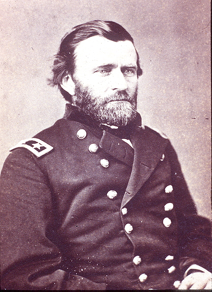U.S. Grant – It is all Relative

In the Personal Memoirs of U.S. Grant, Ulysses S. Grant writes of his being a descendant of Mathew Grant (below). Mathew resided in Windsor, Connecticut in the 17th century and is my paternal 10th great-grandfather (one of my 4,096 10th great-grandparents). No matter how very distant, I share a genealogical relationship with the 18th President of the United States and General-in-Chief of the Union Army during the American Civil War.
Ulysses S. Grant – Personal Memoirs 1885–86
Mathew (Matthew) Grant, the founder of the branch in America, of which I am a descendant, reached Dorchester, Massachusetts [now part of Boston], in May 1630. In 1635 he moved to what is now Windsor, Connecticut, and was the surveyor for that colony for more than forty years. He was also, for many years of the time, town clerk. He was a married man when he arrived at Dorchester, but his children were all born in this country. His eldest son, Samuel, took lands on the east side of the Connecticut River, opposite Windsor, which have been held and occupied by descendants of his to this day. I am of the eighth generation from Mathew Grant, and seventh from Samuel. Mathew Grant’s first wife died a few years after their settlement in Windsor, and he soon after married the widow Rockwell, who, with her first husband, had been fellow-passengers with him and his first wife, on the ship Mary and John, from Dorchester, England, in 1630. Mrs. Rockwell had several children by her first marriage and others by her second. By intermarriage, two or three generations later, I am descended from both the wives of Mathew Grant.
In the fifth descending generation my great grandfather, Noah Grant, and his younger brother, Solomon, held commissions in the English army, in 1756, in the war against the French and Indians. Both were killed that year.
My grandfather, also named Noah, was then but nine years old. At the breaking out of the war of the Revolution, after the battles of Concord and Lexington, he went with a Connecticut company to join the Continental army, and was present at the battle of Bunker Hill. He served until the fall of Yorktown, or through the entire Revolutionary war. – –
My Notes:
- Noah Grant was killed on 20 September 1756 while participating in a 40-day scouting mission with British soldiers and Mohawk warriors out of Ft. William Henry in upstate NY during the French-Indian War).
- The Grant Family of Windsor Connecticut married into the Eggleston Family (Bygod – It is the Eggleston’s!)
- Ulysses S. Grant Papers – The papers of Ulysses S. Grant (1822-1885), army officer and eighteenth president of the United States, contain approximately 50,000 items dating from 1819-1974, with the bulk falling in the period 1843-1885. (Library of Congress)
Copyright © 2021. All Rights Reserved by David R. French
Questions, Comments and Corrections are Appreciated



